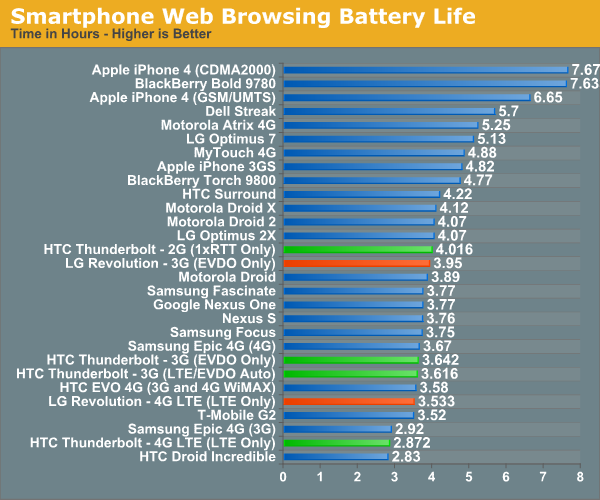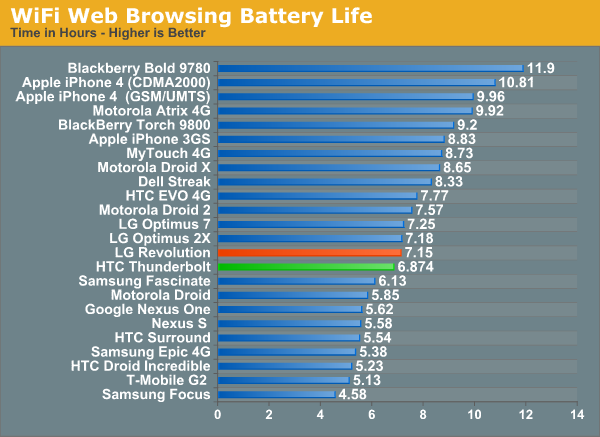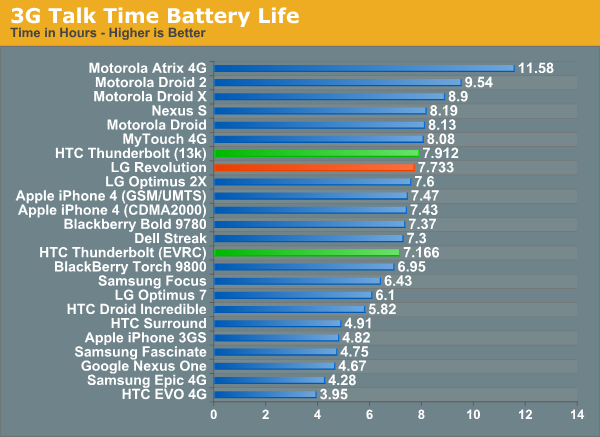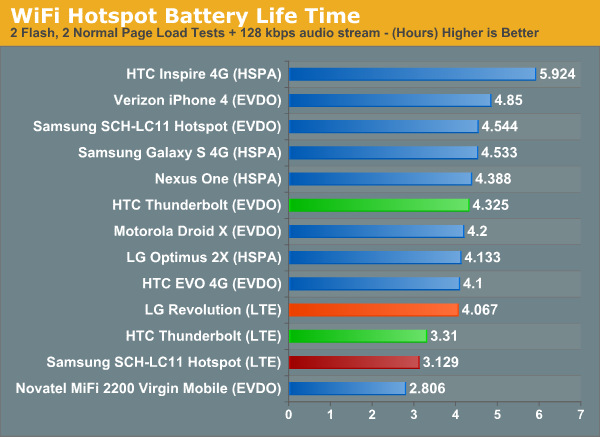LG Revolution: LTE for the Masses
by Vivek Gowri & Brian Klug on June 21, 2011 5:55 AM EST- Posted in
- Smartphones
- Verizon
- LTE
- Mobile
- LG Revolution
LTE battery life, like we saw in the Thunderbolt, is not so hot. It’s better than the TB, partially because the battery is slightly larger (5.6 Wh versus 5.18 Wh in the TB, so about 8% difference). The rest of the difference can be put down to the other main components at work here - the L2000 modem and the screen. Using the Revolution as an LTE hotspot is again a bit better than the Thunderbolt, suggesting that most of the difference is in the modem.




Even though it’s better, that’s still not saying very much. It’s very much in the bottom 10-20% in our benchmarks for battery life under LTE, and while the picture gets better under EVDO, it still doesn’t manage to break 4 hours of web browsing life. Battery performance under WiFi is dramatically better, putting it right between the Optimus 2X and the Thunderbolt and in the same range as the rest of the 4.3” smartphone class. Same goes for talk time, since Verizon is still only using CDMA2000 for voice calls.
But let’s go back to LTE for a moment. Here’s the problem with all of the real 4G devices (LTE and WiMAX only, HSPA+ doesn’t count here). You can’t really use the 4G part of it for very long if you want your device to live through a day. Where that becomes compounded is that with the Verizon devices, there’s no easy way to switch from EVDO to LTE and back. You have to actually sit through and reboot the phone if you want to turn LTE on or off on the LG Revolution. Sprint is much easier, there’s actually a software switch to turn WiMAX on or off, similar to GPS or WiFi on most normal Android phones. It’s a big problem for Verizon, one that I suspect won’t get solved until the LTE modem gets integrated onto the SoC. Qualcomm has one such SoC in the pipeline, the MSM8960, which is built around an entirely new architecture, krait (as opposed to scorpion), and has an LTE modem onboard in addition to all the usual cellular accouterments from 3GPP and 3GPP2. That’s one I’m really looking forward to, but until then, I suspect it’s going to be tough to get an LTE device through a full day on a single charge without an extended battery.










24 Comments
View All Comments
Spoogie - Tuesday, June 21, 2011 - link
In spite of the hype, I’m also turned off by 4G but for different reasons than battery life, though it is also an important consideration.When I purchased a 4G modem in January from Verizon, the connection was intermittent. And it would be down completely while searching for backup 3G… totally unacceptable. Verizon claimed that it should be a good connection based on the geography (Bay Area). Tech support was no help.
Recently I was in the market for a new phone, and while standing in the Verizon store admiring the Samsung Charge, low and behold the phone lost connectivity… while the 3G phones right next to it just hummed right along.
This led me to do some further investigating, and others report similar experiences, such as PhoneDog, who claims he has spotty performance with 4G in Philly and believes it isn’t ready for prime.
Although this doesn't exactly constitute a scientific study, I have no faith in it.
VivekGowri - Tuesday, June 21, 2011 - link
I don't know, I haven't tested LTE anywhere other than Seattle, but I've got coverage basically everywhere I've gone here. Once you head up into the northern parts of the area, to Everett and such, I've lost 4G, but the EVDO handover works pretty seamlessly. Signal strength was usually pretty good too, I was impressed.Impulses - Tuesday, June 21, 2011 - link
Sprint's Wimax may not boast LTE's impressive speeds across most markets, but at least you can seamlessly turn it off/on at the flick of a widget, right out of the box, which makes it easier to preserve battery life when you need to.I've got a question, do VZW LTE phones constantly poll the LTE radio even when outside of LTE markets or is there some software list that shuts them off completely outside LTE markets?
I'm particularly curious because PR isn't likely to have true 4G for a while, yet the carriers sell the very same phones here... Sprint has started testing Wimax in some areas (which is curious since this isn't a Clearwire market), but it seems they're still a long way off before any kind of solid announcement.
In the metro area they're literally just testing it on a handful of towers, and it isn't even on all the time... I guess it might be part of the procedure for their Vision deployment, even if there aren't any permanent 4G plans.
Impulses - Tuesday, June 21, 2011 - link
Oops, just saw you mentioned the same thing about Wimax on the article... I had only read the first and last page when I posted the comment. My question about how LTE is polled or detected on a stock phone still stands tho.I know you can disable it thru service menus and there's probably an app or two that can make that easier, but not everyone that buys these phones outside LTE markets is gonna go looking for those.
wintermute000 - Tuesday, June 21, 2011 - link
for now, good quality HSDPA+ is fine (Telstra user in Australia).Most modern droids can get theoretical 14M down, in practice being able to consistently pull down 1Mb+ almost anywhere, is good enough for anything but streaming. (I have to admit on some days, streaming podcasts cuts up a bit) but raw throughput is fine. '
I'd rather go dual core now and get the LTE phones in a year or two for that price
jonup - Tuesday, June 21, 2011 - link
Can we get these phones down to 100g? Everytime I pick up my coworkers' iPhones and Droids one thought comes to my mind "Why are you so fat when you hauling this brick all day"?vision33r - Tuesday, June 21, 2011 - link
Everytime I see a Thunderbolt user on the train, it's usually for a hotspot and then I see them busting out the blackberry for emails.Right now these LTE devices are only for IT pros that have the need for the speed and the companies paying for them.
They are like every new tech devices just the 1st to market but not ready for mainstream adoption until they fix the power consumption and size.
2nd gen to 3rd gen will replace 3G devices they will take 5 years to happen.
antef - Tuesday, June 21, 2011 - link
That speed is very impressive for a mobile broadband network but honestly who cares? No activity on your phone is going to make much use of anything beyond a few Mbps for things like streaming video. Can you provide a single instance where you'll notice 3 Mbps vs 18 Mbps except when running the Speed Test app? In addition to that, with Verizon's rumored upcoming 2 GB cap on $30 data plans, the speeds are even less appealing. What we need is better battery life, higher caps (or no caps), and reliable, good enough throughput anywhere you go (~3 Mbps or so), not absolute blistering speeds.DigitalFreak - Tuesday, June 21, 2011 - link
That's why you buy before the cap gets implemented.VivekGowri - Tuesday, June 21, 2011 - link
Streaming video, mostly. LTE is so fast that we've gone back to smartphone browsing being limited by how fast the phones can render pages.